DARREN PORTER spends about 250 days a year on the water, navigating the rivers of central Nova Scotia that flow out into the upper Bay of Fundy. It’s this network of waterways that provides a livelihood to him and the other local fishers and Mi’kmaq communities nearby.
Porter’s long days on the boat have left an indelible imprint. The ebb and flow of the tides, the spawning grounds and seasons of different aquatic species, the human footprint on the land and water: it’s all been etched into his brain. Porter’s knowledge and understanding, gained through the fishing and research operation he runs with his daughter, Erica, have brought many to knock on his door over the years.
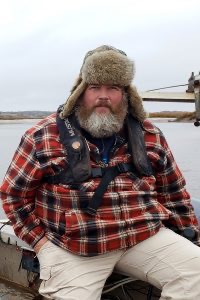
The Mi’kmaw Conservation Group, a program administered by the Confederacy of Mainland Mi’kmaq, calls on him regularly to partner on conservation research linked to culturally important species in the Fundy watershed. And, on several occasions, he’s been invited to Dalhousie to swap stories and knowledge with students and academics similarly passionate about marine matters.
During one such visit to campus, Porter met Fred Whoriskey, executive director of the Ocean Tracking Network—a Dal-based research organization that deploys Canadian-made acoustic receivers and oceanographic monitoring equipment to tag, track and monitor the movements of marine animals. Not long after this meeting, Porter was working on a survey project with a Mi’kmaw community and needed tracking tags to get the job done. He called Dr. Whoriskey to see if he could assist.
Within two days, Porter had his receivers.
It was the beginning of a powerful partnership. Now, years later, the two are working together on Apoqnmatulti’k, an NSERC-funded study tracking valued aquatic species in the Bay of Fundy and Bras d’Or Lake in Cape Breton. The uniqueness of the initiative lies in the intention underpinning it: to learn from the strengths of each other’s perspectives and guide and develop the research together.
“We are on the water all the time, but our knowledge can be easily dismissed because it’s not validated by an academic system,” says Porter.
The Apoqnmatulti’k project, by contrast, has created more formal pathways to bring different knowledge systems—Mi’kmaw knowledge, local knowledge, Western knowledge—together to produce science that inspires trust among everyone involved.
“We’re ending conflict by working together on a shared resource, not in a silo. We’re not using data as a commodity—data is shared information to protect and look after ecosystems,” says Porter. “It’s a true social license. It’s trusted. Before, the science was not trusted.”
Apoqnmatulti’k—Mi’kmaq for “we help each other”—is a powerful example of a partnership rooted in shared priorities. And it’s these kinds of collaborations with local communities that Dalhousie is aiming to build more of in the years ahead.
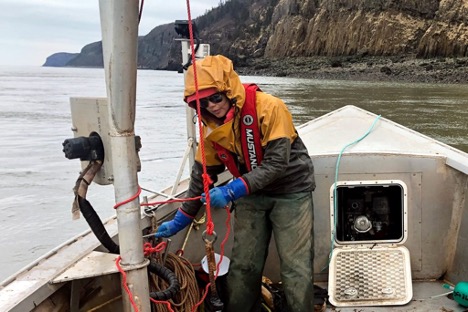
Erica Porter has worked on the Bay of Fundy and Minas Basin since she was 16 years old.
UNIVERSITIES ARE CIVIC institutions by design. They attract aspiring learners to the cities, towns and regions where they are located, they shape the landscape and culture of those places with their infrastructure and facilities, and they train people entering the workforce.
Without Dalhousie, for instance, Halifax and Truro—where the university’s four primary campuses are located—would no doubt be very different places. The same could likely be said about thousands of communities around the world that serve as home base for post-secondary institutions.
But what happens when universities become even more intentional about their civic role, when the passive benefits they pass on in the natural course of operations are coupled with initiatives expressly created to help meet the needs of communities nearby?
Cast a glance across the Atlantic Ocean to the U.K., and you’ll discover an entire national network of universities emerging to test these very questions. Universities there have formalized partnerships with governments, community organizations and the private sector in recent years, creating impact agreements and strategic investments centred around specific, shared priorities. To Canada’s south, civic-mindedness lies at the very heart of the mission of universities in the “land-grant” tradition—institutions first created through the transfer of U.S. federal lands to states after 1862 in return for a promise to use any proceeds from their sale to establish and endow colleges to teach subjects that helped the country meet the needs of its rapidly industrializing regions.
“We can learn a lot from both of those traditions,” says Matt Hebb, vice-president of government and global relations at Dalhousie.
Hebb is at the forefront of Dalhousie’s own efforts to develop a more deliberate approach to supporting the communities and regions of Nova Scotia. While Dalhousie has carried out some form of a civic mandate since its founding more than 200 years ago, a more intentional approach is needed now in order to harness benefits for local communities as the university becomes increasingly global in scope, he says.
“Our own future as an institution is completely intertwined with the future of the province,” says Hebb. “We can’t imagine a bright future for ourselves as a university in the absence of also imagining a bright future for our province.”
Third Century Promise, the university’s new five-year strategic plan released this past summer, essentially codifies this ethos in one of its five main strategic pillars: ‘Civic university with global impact.’
As executive lead of the pillar, Hebb will play a pivotal role in bringing key players from the university and community together to discuss shared priorities. In some cases, the groundwork for these discussions has already been laid.
Consider Imhotep’s Legacy Academy (ILA), a Dal-based mentorship program that uses engaging activities and meaningful mentorship to encourage more youth of African heritage in Nova Scotia to explore science, technology, engineering and mathematics (STEM) fields. ILA is a prime example of how the university has worked along with governments and schools in an intentional way to help improve access to higher education among communities that historically and currently face barriers—one of the action items in Dal’s strategic plan.
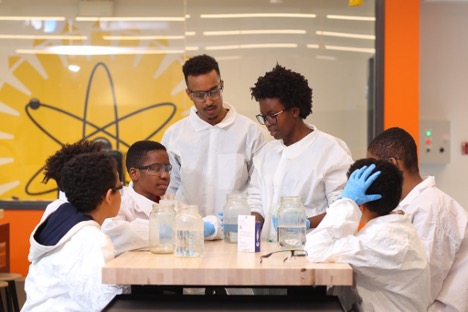
Students at Imhotep’s Legacy Academy on their way to becoming tomorrow’s STEM experts.
ILA’s after-school outreach, online tutoring and scholarship programs have proven a winning mix with learners who often stick with the program from their junior high days through high school and beyond. Sidney Idemudia, the group’s executive director, has attributed ILA’s success to two things: keeping learners engaged over an extended period and its emphasis on hiring mentors who are themselves of African heritage and relatively close in age to mentees.
After close to 20 years in service, ILA just keeps getting stronger. In the last five years, ILA has served more than 1,100 students per year on average across the province and recently expanded some of its programs to be offered in French.
Ibrahim-Khalil Yaffa, a 15-year-old Haligonian ILA participant in Grade 11 with family roots in Sierra Leone, is unambiguous in describing ILA’s importance to him.
“You could ask me ‘What has ILA done for you?’ and my response would be, ‘What has ILA not done for me?’” He says the program has enhanced his confidence, improved how he interacts with people, and taught him important lessons not only in STEM but in life more generally. “I’ve had lots of trouble in many different things, whether it be choices I’ve made or my studies in school, and knowing that I have a community, a family like Imhotep behind me has really helped.”
Hebb sees ILA as a potential model for further outreach activities in subjects beyond STEM, an idea Asher Trim-Gaskin (BSc’17), the group’s current program manager and a Dal Biology alum, finds intriguing as well. Trim-Gaskin says he could imagine a similar mentorship program set up for business, planning, architecture and other social sciences.
“The key is continuing to keep the mentorship aspect of ILA where university professors mentor university students, and then, in turn, university students mentor junior high and high school students. We need to keep that representation through all three stages and keep the positive cycle going.”
Dal’s Transition Year Program and the Schulich School of Law’s Indigenous Blacks & Mi’kmaq Initiative are two other distinct, long-standing successes in this arena that provide access to higher education. The Sankofa Scholarships for Black students and the tuition waiver program that offers free tuition for youth formerly in foster care, both launched by Dal this year, extend the idea even further.
Together, they illustrate momentum. Now, says Hebb, is the time for Dalhousie to be even more intentional and directed in conversations with communities about such efforts. He is leading the development of an impact charter with community partners, a document that will frame priorities and tactics.
“Something like an impact charter gives us an opportunity to knit different initiatives and relationships together into a platform for really intentional social and economic impact in Nova Scotia.”
"Knowing that I have a community, a family like Imhotep behind me has really helped.”
THE FIRST LAND-GRANT colleges established in the U.S. launched in the 1860s with a mission to focus on subjects with practical applications. Agriculture, engineering, science and military science were four key fields of study, in stark contrast to the Ivy League’s often heavy emphasis on the liberal arts. The economy was changing and therefore education needed to follow suit and provide people with the skills they needed to be of use in the workforce, went the logic.
Today, many U.S. land-grant institutions have grown to become more comprehensive universities with a full slate of academic offerings and research expertise that stretch well beyond their original areas of focus. But there’s a kernel of that original mission that continues to shine through and serve as a guiding light for these universities in the land-grant tradition. Purdue University in Indiana, Ohio State University, the University of Illinois (Urbana), and the University of Wisconsin (Madison)—all now considered among the top public universities in the U.S.—are well-known land-grant schools that remain embedded in communities across the states where they reside.
It’s a tradition that continues to inspire other universities, including Dalhousie. The addition of two land-grant founding disciplines—engineering and agriculture—at Dal within the last 25 years provides greater impetus and scope for the university to influence Nova Scotia’s economic trajectory.
And this recognition that post-secondary institutions can play an important role in driving regional economic activity continues to evolve—especially when rapid changes are afoot.
Take the tech boom currently underway and the digital firms redefining nearly every sector of the Canadian economy. Nova Scotia and Halifax, in particular, have suited up to ride the wave, bolstered by a steady supply of talented tech workers graduating from universities across the province.
There’s a problem, though: there’s not enough of them.
To meet demand and grow its digital footprint further, Nova Scotia has partnered with post-secondary institutions across the province, investing $16.8 million to help expand and enhance computer science education. Dalhousie, where student enrolment in the Faculty of Computer Science has more than doubled since 2016, was offered $13.3 million of the funds as part of the project.
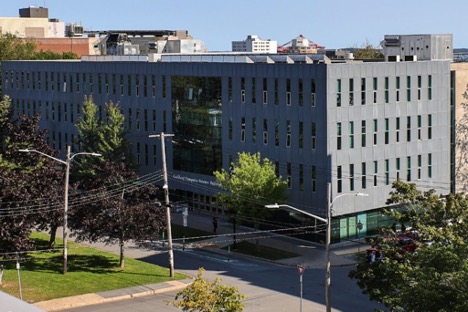
Dalhousie’s Goldberg Computer Science Building.
“Look at the moment we are in now as we begin to transition out of the COVID-19 pandemic. Software technology has enabled us to manage and, in many ways, thrive through this period,” says Andrew Rau-Chaplin, dean of the Faculty of Computer Science and Dal’s lead on this initiative. “Computer scientists are in demand across all industries and sectors, and roles in tech allow you to live and work anywhere.”
The province’s investment will benefit Dalhousie directly by attracting additional talented faculty members to the university. Many new hires are expected as part of the project. This will help the Faculty meet the enrolment boom and push teaching and research into new areas, but as Dr. Rau-Chaplin says, it’s about much more than Dalhousie’s needs.
“Really, in large part this investment is not a reaction to the needs of the Faculty or the needs of Dal, but a response to how we connect to the economic and social well-being of Nova Scotia,” he says.
That means working closely with partners ranging from the private sector to the P-12 education system to ensure the development of a robust digital talent pipeline for the province.
“I think the biggest mistake we could make would to be overly Dal-centric about this. We have to do this with partners,” he says. “It’s not just about producing more talent, it’s the right talent with the right education. It’s not just about producing more students, it’s about students from diverse backgrounds and diverse perspectives that can really represent us as a whole society.”
INTEGRATING DALHOUSIE'S GOALS more intimately with those of the communities it touches will take time. It will also require the continued support of government, the private sector and other players as priorities shift. While a flourishing economy remains an important collective good for all, Dalhousie’s effectiveness as a civic partner obviously means a lot more than that these days, explains Hebb. “To me, it’s impossible to imagine any of these ambitions or objectives being achieved if we’re not taking on the important work of reconciliation and inclusion, diversity, accessibility. These priorities are critical and there’s no more important place to do this than at a university, which is fundamentally about taking people through transformative processes and setting them up to go forth in productive ways into other parts of society and the economy.”
City ShaperHow Dal’s facilities foster stronger social bonds and community well-beingDalhousie’s facilities serve the university community day after day. But they’ve also proven beneficial to those beyond the university’s campuses—to campus visitors and, of course, to people sharing the neigh-bourhood. Below, we explore a few of Dal’s most popular public destinations and how they’ve served as a powerful force for good. Dalplex and its siblings
Wagon stop ahead
A place to be inspired and entertained
|
This story appeared in the DAL Magazine Fall 2021 issue. Flip through the rest of the Fall 2021 issue using the links below.

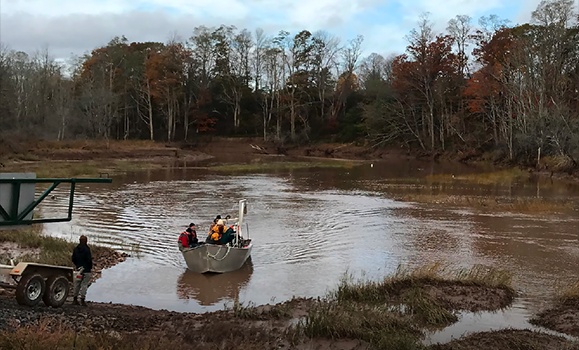
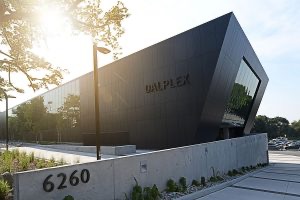 Deep within the heart of Dalplex, the university’s flagship fitness and athletics complex, lies the fieldhouse. It’s there, on one of four full-sized basketball courts that professors, students, staff and neighbours alike assemble weekdays between 11:30 and 1:30 to battle it out over some ball. Noon Hoops is a drop-in, pick-up, co-ed basketball league that’s open to anyone who wants to play. Founder Herb Gamberg, who ran the league for close to 50 years, told The Coast “It’s the sheer pleasure of having something to do in the middle of the day, without stress” that accounts for the league’s longevity. Noon Hoops is one of dozens of programs open to the public at Dal’s fitness facilities, including children’s camps.
Deep within the heart of Dalplex, the university’s flagship fitness and athletics complex, lies the fieldhouse. It’s there, on one of four full-sized basketball courts that professors, students, staff and neighbours alike assemble weekdays between 11:30 and 1:30 to battle it out over some ball. Noon Hoops is a drop-in, pick-up, co-ed basketball league that’s open to anyone who wants to play. Founder Herb Gamberg, who ran the league for close to 50 years, told The Coast “It’s the sheer pleasure of having something to do in the middle of the day, without stress” that accounts for the league’s longevity. Noon Hoops is one of dozens of programs open to the public at Dal’s fitness facilities, including children’s camps. 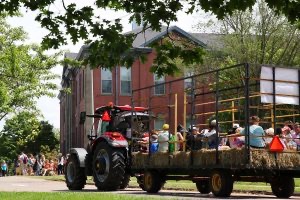 Each summer, the Faculty of Agriculture invites the public to enjoy the relaxed splendor of its bucolic campus situated on farmland near Truro, Nova Scotia, on Community Day. People hop on a wagon for a ride, sample culinary pleasures from the BBQ and ice cream freezer and tour the many gardens, pastures and animal facilities on campus—making memories that will last well after the tractor has been parked for the day.
Each summer, the Faculty of Agriculture invites the public to enjoy the relaxed splendor of its bucolic campus situated on farmland near Truro, Nova Scotia, on Community Day. People hop on a wagon for a ride, sample culinary pleasures from the BBQ and ice cream freezer and tour the many gardens, pastures and animal facilities on campus—making memories that will last well after the tractor has been parked for the day. 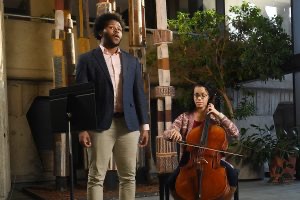 The
The